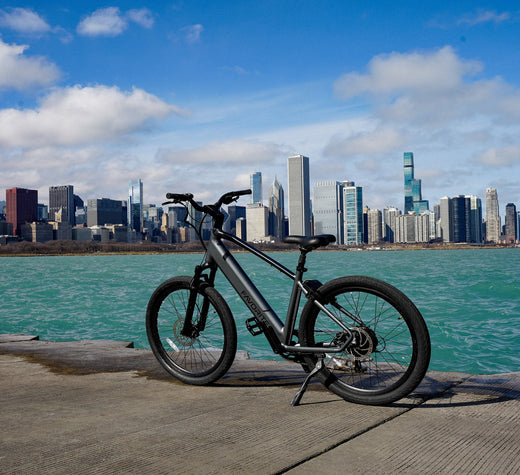
Understanding and Preventing Power Loss in Electric Bike Motors: A Complete Guide
Electric bike motor power loss can impact performance, limiting speed, range, and overall efficiency. This guide explores the causes of power loss in e-bike motors and offers practical solutions to keep your e-bike running at its best.
Understanding Electric Bike Motor Power Loss
Power loss in an e-bike motor occurs when energy intended for propulsion is lost due to inefficiencies in the motor system. Factors like heat, friction, resistance, and aging components can reduce the motor's effectiveness in converting battery power into movement. Knowing these causes is crucial for maintaining peak performance and getting the most out of your electric bike.
Key Causes of Power Loss in E-Bike Motors and How to Address Them
1. Heat Build-Up (Thermal Loss)
Heat build-up is a primary contributor to power loss, especially during long rides or when carrying heavy loads. As the motor generates heat, efficiency decreases, leading to energy loss.
- Solution: Ensure proper ventilation around the motor to prevent overheating. High-quality motors often come with integrated cooling systems, but regular maintenance is essential. Clear any blockages that could restrict airflow, and take breaks on long rides to allow cooling.
2. Electrical Resistance
Resistance within wires, connectors, and other components converts electrical energy into heat, decreasing the power delivered to the motor.
- Solution: Use high-quality, low-resistance wiring and connectors. Regularly inspect components for wear, corrosion, or loose connections, as these can increase resistance and reduce power efficiency.
3. Mechanical Friction
Mechanical components in the motor, such as gears and bearings, can wear out over time, creating friction that leads to power loss.
- Solution: Lubricate gears, bearings, and other moving parts regularly, and replace worn components when necessary. High-quality bearings and parts can reduce friction, ensuring a smoother ride and better energy transfer.
4. Inefficient Motor Design
Older or lower-cost motors may not efficiently convert electrical power to movement, resulting in wasted energy.
- Solution: Opt for a high-efficiency brushless motor (BLDC) when upgrading or purchasing an e-bike. Brushless motors are more effective at energy conversion and require less maintenance than traditional brushed motors.
5. Battery Efficiency Loss
As e-bike batteries age, they may lose efficiency, impacting their ability to deliver consistent power to the motor. Additionally, internal resistance in the battery can lead to power loss during charging and discharging.
- Solution: Monitor battery performance and replace it if you notice significant power loss or decreased range. High-quality lithium-ion batteries are known for better efficiency and longevity, making them a sound investment for maintaining motor performance.
6. Controller Power Conversion Loss
The controller is responsible for converting battery power into a form usable by the motor. An inefficient controller can cause significant power loss during this conversion.
- Solution: Choose a controller designed for efficiency and matched to your e-bike’s motor. Ensuring compatibility between the motor and controller will minimize conversion losses, allowing for optimal power delivery.
7. Overloading the Motor
Running the motor at maximum power for extended periods, or carrying heavy loads, can cause overheating and reduce motor efficiency.
- Solution: Avoid overloading your e-bike by staying within recommended weight limits. If you regularly ride in challenging conditions, consider upgrading to a motor designed for higher loads to ensure smooth performance without overstrain.
8. External Factors: Aerodynamic Drag and Tire Resistance
Factors like wind resistance and tire drag force the motor to work harder, reducing its efficiency.
- Solution: Use low-resistance tires and keep them properly inflated to reduce rolling resistance. Streamlining accessories, such as narrow handlebars or a low-profile helmet, can reduce aerodynamic drag, improving overall motor efficiency.
9. Wiring and Connection Issues
Loose or corroded connections between the motor, battery, and controller can disrupt power flow, leading to increased resistance and inefficient power transfer.
- Solution: Inspect all electrical connections regularly to ensure they are tight, clean, and corrosion-free. Replace any damaged wires or connectors to maintain a reliable power supply to the motor.
10. Software or Controller Settings
Many e-bike systems include software that limits power output to protect the motor. Overly conservative settings can reduce motor efficiency and limit performance.
- Solution: Check your e-bike’s manual to ensure controller settings are optimized for performance. Consulting a professional may help you adjust the settings to achieve a balance between power and component protection.
Optimizing Electric Bike Motor Performance
To minimize power loss and maintain peak e-bike performance, keep these best practices in mind:
- Regular Maintenance: Clean, lubricate, and inspect all mechanical and electrical components. This reduces friction and resistance, helping prevent unnecessary power loss.
- Upgrade When Needed: If you’re experiencing significant power loss, consider upgrading to high-efficiency components, such as a brushless motor or low-resistance wiring.
- Monitor Battery Health: Regularly check your battery’s performance. Replacing an aging or degraded battery can help sustain consistent power delivery.
- Stay Within Weight Limits: Avoid overloading your motor, as excessive weight reduces efficiency and increases strain.
- Reduce Aerodynamic Drag: Simple adjustments, like choosing low-resistance tires and reducing drag, help keep the motor from working harder than necessary.
By following these steps, you can reduce power loss, maximize the lifespan of your e-bike components, and enjoy a smoother, more efficient ride.
No comments










0 comments